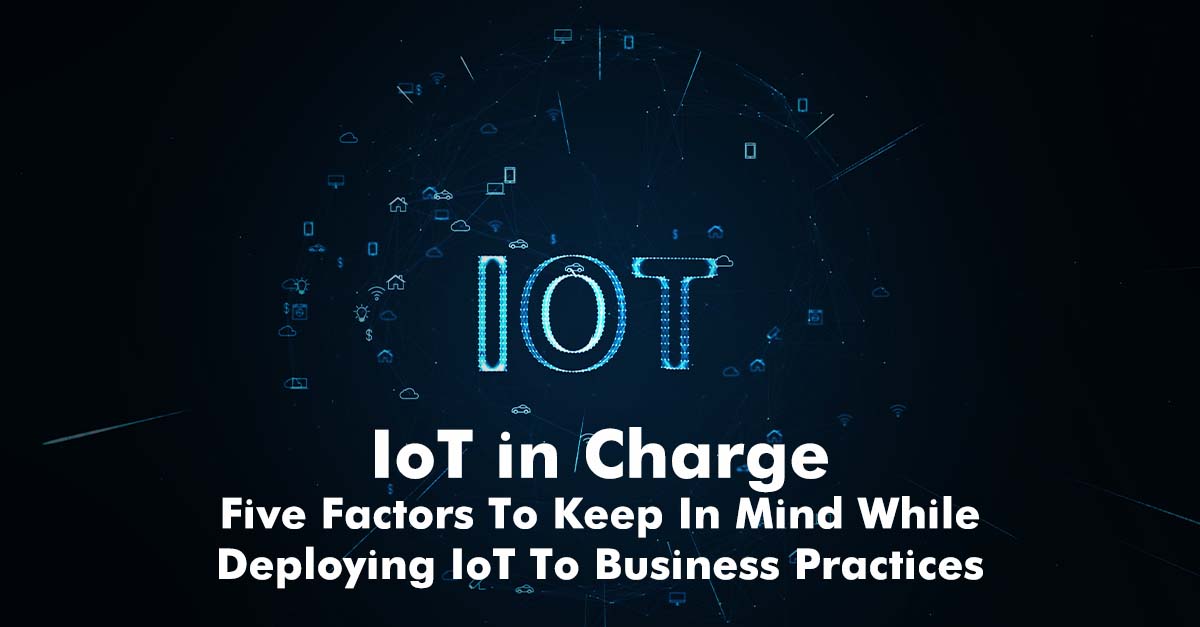
IoT Deployment in Charge: Five Factors To Keep In Mind While Deploying IoT To Business Practices
“The Internet of Things (IoT) deployment is not only a medium that uses a set of technologies and applications to bring devices and locations together by connecting them and inferring smart decisions but a lot more than that, based on which the very foundation of smart technology lies.”
Came Industrial Revolution 4.0, which undoubtedly changed the way businesses work, resulting in digital transformation; giving rise to digital business practices and solutions across the sectors.
Connecting the devices to the internet with the help of sensors is what defines the Internet of Things. Be it a fitness tracker, a light bulb, or even an appliance, they get connected to the internet using sensors.
IoT in Charge:
We observe that objects connected to the internet will make them smart; and also giving rise to the Internet of Things these days.
A recently conducted research suggests that almost 100 billion IoT devices will be connecting to the internet; creating a global economic impact of more than $11 trillion by 2025. The concept of combining computers, sensors, and networks to monitor and control devices has existed for decades, but due to the rise in digitization and the prevalence of IoT devices, the surge in IoT technologies has increased more than ever these days.
Emerging technologies such as IoT, Big Data Analytics, Cloud & AI are a few of the ‘big four technologies’ ruling the technology space. And providing the bedrock to connect organizations, generate data, and drive more intelligent operations.
According to a recent survey, the spending on software and hardware related to IoT is expecting to reach approximately USD 1 trillion in 2023 across the world, covering the pre-and post-COVID-19 market analysis.
Deployment of IoT is not as easy as it looks; It is easy to say that deploying IoT at a more significant business organization is easier than doing it. It will be hyperbole if IoT deployment is taken as a cakewalk, considering the risks and uncertainties.
Mitigating these risks should be one of the crucial factors while deploying the IoT. And, while IoT deployment, it can be a concern that must be taken into consideration.
Five Things to Keep In Mind While IoT Deployment To Business Practices:
Acceptable Performance Range:
Since most devices with different processing power and storage levels connect to the internet these days; there are always changes and vulnerabilities that vary in their performance and flux, giving rise to inefficiencies and inconsistencies.
Bringing the devices on an acceptable performance range results in increased workload and consistency throughout the connected networks.
Device Management:
Usually, the traffic created with the volume of devices generates challenges to manage them. Basic activities such as upgrading the firmware can be an arduous quest if we don’t have a system that allows us to roll out these changes efficiently and adequately.
Hence, organizations stress upon rolling out a sound and comprehensive strategy that focus on device management.
Security of Devices:
Many devices that connect to the internet make smart decisions are always prone to attack, so their security becomes of utmost importance. The connected devices store sensitive data, which is vulnerable to access by attackers.
However, to mitigate such cases, organizations are investing aggressively in the encryption of these devices to avoid these possible threats.
Saturation Time:
With a plethora of devices connecting to the internet these days, a massive chunk of data is processing these days. When processed in real-time and near real-time or batch, this data reaches a saturation period after a specific time.
For instance, a smartwatch streams data in real-time of our running performance when we are exercising or a historical dashboard showing the telemetry of sensors of a vessel keeping track of the fuel consumption is another example of near real-time. Hence, saturation time plays a vital role in maintaining the efficiency and effectiveness of IoT technology. And, thus, to keep this in mind while deploying IoT.
Integration of Data and Devices:
With the continuous rise in technology changes, the evolution of the devices, and the integration practices changing with time, it becomes imperative to use the IoT technologies and IoT applications.
The integration of data with the devices is taken so that emerging technologies in this fast-growing business, without causing damage or downtime of the whole ecosystem.
Conclusion – IoT Deployment:
Fortunately, these days, IoT solutions offer customization to deal with the risks and issues that may arise during the deployment of the IoT solutions to business practices that are potential enough to hamper the overall business practices.
Some IoT technologies providers offer simple solutions, and others have increasing degrees of complexity; while some are open source, whereas some are licensed. However, the services and solutions customize, offer and integrate, to the extent that is choosing between an existing platform or building one from the very basic always lies in the hands of the organizations.
Hence, while Iot Deployment, the above-discussed factors should be kept in mind.





